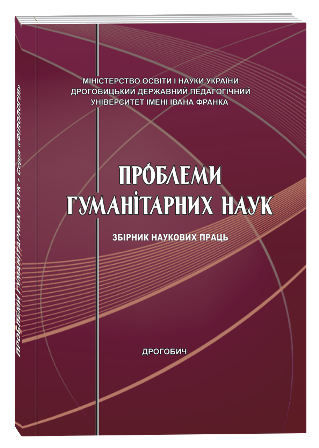POLYCODE TEXTS WITH THE CONCEPT OF “CORONAVIRUS”
DOI:
https://doi.org/10.24919/2522-4565.2021.46.1Keywords:
polycode text, concept, coronavirus, poster, conditional zero heterogeneity, nonzero sufficient and excessive heterogeneityAbstract
The article examines the polycode texts of posters with the concept of “coronavirus”. The author emphasizes that the reality of the epidemic turned out to be so shocking for the society that the Ukrainian language reacted immediately to this process, creating a significant array of innovations. The spread of coronavirus required logical communication to influence Ukrainians’ emotional, behavioural and psychological state, providing them with information about the disease, culture of social contacts. Information posters made this moment possible. The relevance of this work is determined by the prospect of various aspects of the concept of “coronavirus”, particularly semiotic systems of polycode texts about COVID-19. The purpose of the article is to explore polycode texts of posters with the concept of “coronavirus”. It is determined that the texts are written, static, explicitly expressed (available verbal and visual components) formation. According to the degree of heterogeneity, two groups were recognized. Conditional zero heterogeneity (verbal component accompanied by an iconic image). Non-zero heterogeneity has two subspecies: sufficient (verbal component and images are consistent in content); excessive (verbal language component exceeds the pictorial). It is explained that each group of polycode texts conditioned its comprehension through the prism of language representatives, which are realized at certain language levels. It is concluded that the concept of “coronavirus” in the studied texts is actualized by the concepts of “life”, “health”, “safety”, which in the structures with non-zero heterogeneity are attached to the concepts of “medicine”, “disease”, “human”, “age”. Prospects for research – in-depth analysis of signs of different language levels in polycode texts with the concept of “coronavirus”.
References
Ганєчко В. Термінологічна лексика за часів COVID-19: номінативний аспект. Грааль науки. 2021. № 5. С. 209–213. DOI: https://doi.org/10.36074/grail-of-science.04.06.2021.038.
Жаботинская С.А. Нарративный мультимедийный концепт: алгоритм анализа (на материале интернет-мемов о COVID-19). Cognition, communication, discourse. 2020. № 20. С. 92–117. DOI: 10.26565/2218-2926-2020-20-06.
Завадська О.В. Феномен креолізованого тексту: актуальна проблема сучасних лінгвістичних досліджень. Лінгвістичні дослідження. 2016. Вип. 43. С. 163–169. DOI: https://doi.org/10.5281/zenodo.49222.
Інформаційні постери про коронавірус. URL: https://www.google.com.ua/search?source=univ&tbm=isch&q=інформаційні+постери+%20про+коронавірус&hl=ru&sa=X&ved=2ahUKEwjj2KLz_KDyAhVhtIsKHZM_CwwQjJkEegQICBAC&biw=1496&bih=754 (дата звернення 15.07.2021).
Косович О. Глобальний виклик коронавірусній пандемії: мовні зміни. Мова. Свідомість. Концепт. 2021. Вип. 11. С. 29–32.
Красницька К., Степанюк Н., Долусова Н. Глобальне явище CORONAVIRUS як новий концепт в англомовній лінгвокогнітивній картині світу. Актуальні питання гуманітарних наук : міжвузівський збірник наукових праць молодих вчених Дрогобицького державного педагогічного університету імені Івана Франка. Дрогобич : ВД «Гельветика», 2020. Вип. 32. Т. 1. С. 148–153. DOI: https://doi.org/10.24919/2308-4863.1/32.214491.
Пойманова О.В. Семантическое пространство видеовербального текста : автореф. дисс. … канд. филол. наук : 10.02.19. Москва : МГЛУ, 1997. 24 с.
Федоров А.В., Левицкая А.А., Новиков А.С. Коронавирус как источник медийных манипуляций. Crede Experto: транспорт, общество, образование, язык. 2020. № 2. С. 69–80.
Чуланова Г. Прагматика синтаксису в рекомендаціях ВООЗ для громадян щодо коронавірусу. Abstracts of the 11th International scientific and practical conference (Barcelona, November 1-3, 2020). Barcelona : Barca Academy Publishing, 2020. С. 459–464.
Dada S., Ashworth H., Bewa M.J. & Dhatt R. Words Matter: Political and gender analysis of speeches made by heads of government during the COVID-19 pandemic. medRxiv. Cold Spring Harbor Laboratory Press, September 2020. DOI: https://doi.org/10.1101/2020.09.10.20187427.
Jovanovic S.M. Discursive governmental and media response to COVID-19: the case of Serbia. Society Register, 2020, Vol. 4, № 2, Р. 95–108. DOI: https://doi.org/10.14746/sr.2020.4.2.07.
Roig-Marín A. English-based coroneologisms. A short survey of our Covid-19-related vocabulary. English Today, First View. Cambridge University. 2020. Р. 1–3. DOI: https://doi.org/10.1017/S0266078420000255.



